 금속 판재 양식
금속 판재 양식
![]()
![]()
![]()
기존 금속 판재 모델에 양식 피처를 생성합니다. 현재 통합문서, 다른 통합문서 또는 미리 정의된 금속 판재 양식 라이브러리에서 양식을 선택할 수 있습니다.
Onshape는 Onshape 금속 판재 양식 라이브러리의 일부 표준 양식과 함께 제공됩니다. 사용자 지정 양식을 사용하려면 양식 피처 대화상자에서 액세스하기 전에 먼저 사용자 지정 양식을 만들어야 합니다. 자세한 내용은양식 생성을 참조하십시오.
양식 피처를 추가하기 전에 Part Studio에서 생성한 금속 판재 모델이 있는지 확인하십시오.
- 금속 판재 모델이 있는 Part Studio에서 피쳐 툴바의 양식 아이콘(
 )을 클릭합니다.
)을 클릭합니다. 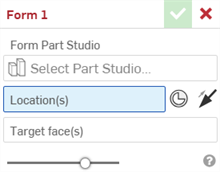
- Part Studio 선택 필드를 클릭하여 Part Studio 선택 대화상자를 엽니다.
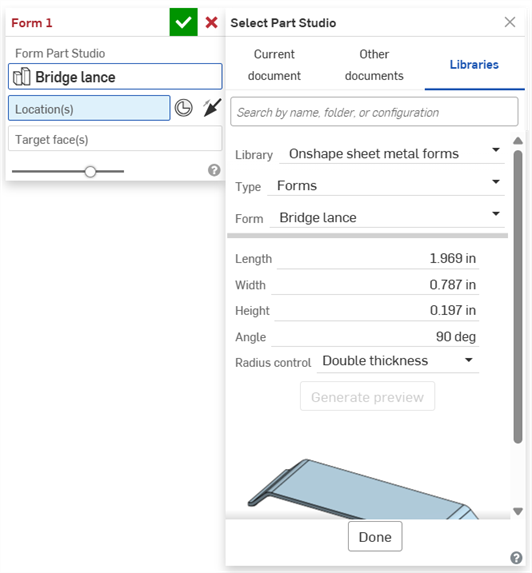
현재 통합문서, 기타 통합문서 또는라이브러리(Onshape 금속 판재 양식 라이브러리 또는 사용자 및 엔터프라이즈/Company 양식 라이브러리를 선택할 수 있음) 중에서 선택합니다.
라이브러리, 유형(양식이 생성된 통합문서) 및 양식(양식이 생성된 Part Studio)을 선택합니다. 필요에 따라 검색창을 이용할 수도 있습니다.
통합문서의 1 Part Studio에 양식이 하나만 있는 경우, 유형 필드가 표시되지 않습니다.
양식에 사용할 수 있는 추가 구성 변수가 있는 경우 필요에 따라 해당 값을 입력합니다.여기에 있는 브리지 랜스 예제의 경우 양식에길이, 너비, 높이 및각도 변수를 사용할 수 있습니다.
완료를 클릭하여 양식을 추가합니다.
- 스케치 꼭지점, 점 또는 명시적 메이트 커넥터를 선택하여위치 형식을 선택합니다. 메이트 커넥터 아이콘(
 )을 클릭하고 모델 위로 마우스를 가져가 암시적 메이트 커넥터를 선택할 수도 있습니다.
)을 클릭하고 모델 위로 마우스를 가져가 암시적 메이트 커넥터를 선택할 수도 있습니다. 
- 필요에 따라, 반대 방향 화살표(
 )를 클릭하여 대상 면의 반대 방향으로 양식을 반전시킬 수 있습니다.
)를 클릭하여 대상 면의 반대 방향으로 양식을 반전시킬 수 있습니다. - 아직 선택하지 않은 경우 양식을 배치할 금속 판재의 대상 면을 선택합니다.
- 체크마크(
 )를 클릭하여 새 양식 피처를 수락합니다.
)를 클릭하여 새 양식 피처를 수락합니다.
형태가 금속 판재 모델 및 플랫 패턴에 추가됩니다.
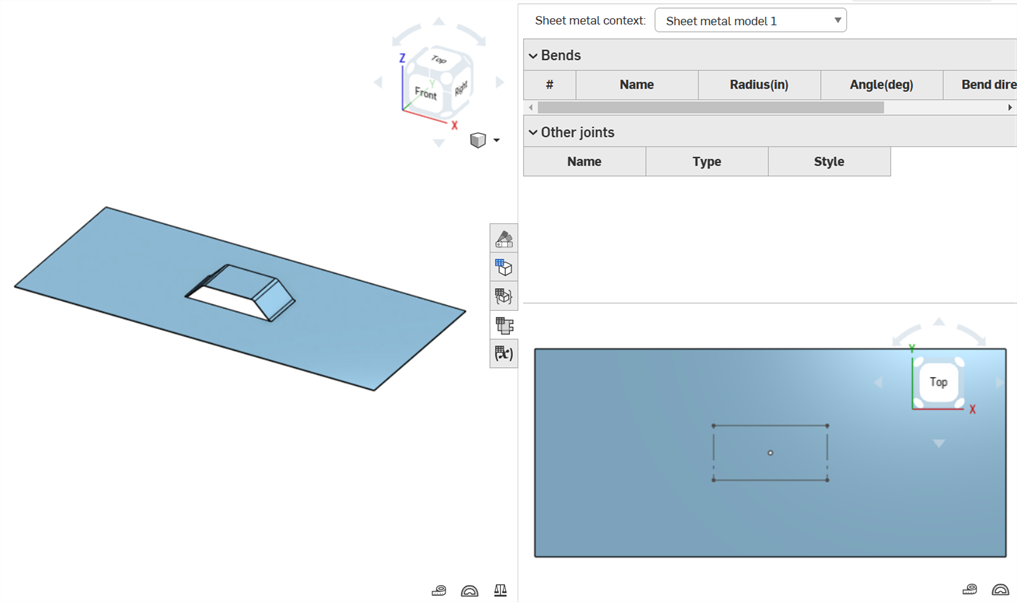
아래의 루버 양식 설계는 양식의 상단, 측면 및 등각투영 뷰를 해당 태그 피처(상단)와 함께 보여줍니다. 그런 다음 이 양식을 양식 피처에 사용하여 금속 판재 모델 면의 스케치 점(하단)에 적용합니다.
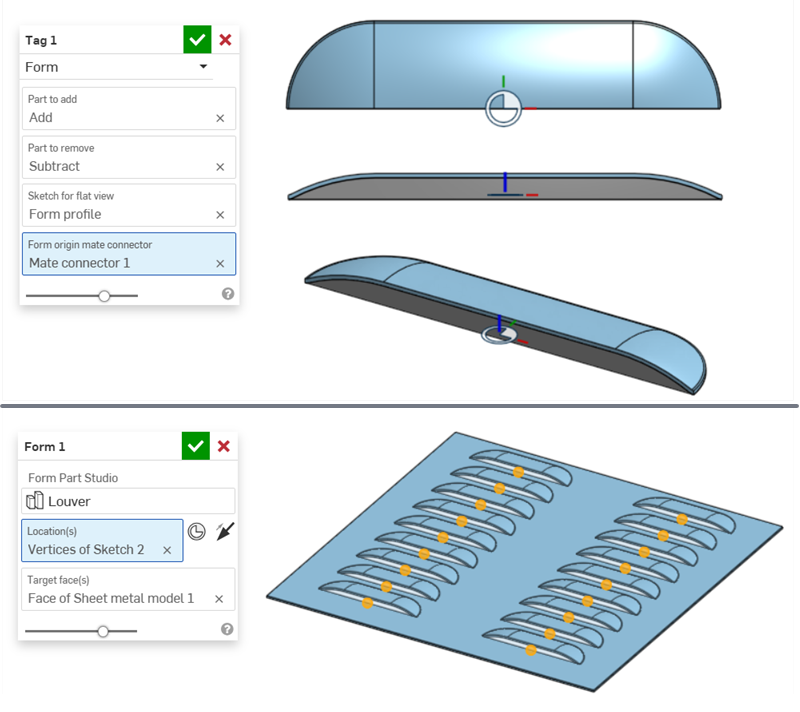
-
태그 피처는 파란색추가 파트를 사용하여 금속 판재 모델에 추가하고 회색 빼기 파트를 사용하여 금속 판재 모델에서 제거합니다.
-
메이트 커넥터를 배치하면 빼기 파트가 금속 판재에 연결되고 동시에 추가 파트가 금속 판재에 부착됩니다.
-
양식의 태그 피처에 있는 양식 원점 메이트 커넥터(메이트 커넥터 1)에 따라 양식의 원점이 결정됩니다. 이 양식을 금속 판재 면(금속 판재 모델 1의 면)의 스케치 꼭지점(스케치 2의 꼭지점)에 배치하면 양식의 메이트 커넥터가 금속 판재의 스케치 꼭지점에 맞춰 정렬됩니다.
-
또는 명시적 메이트 커넥터를 사용하여 양식을 금속 판재 모델에 맞게 정렬할 수 있습니다. 아래 예에서는 양식 피처의 위치에 스케치 꼭지점 대신 메이트 커넥터(메이트 커넥터 2)는 스케치 꼭지점 대신 양식 피처의 위치에 사용됩니다. 메이트 커넥터의 보조 축은 180도 회전하고 메이트 커넥터와 양식 피처는 모두 위와 동일한 모델을 생성하도록 패턴화되지만 루버는 회전합니다.

-
-
폼은 금속 판재의 측면 벽, 압연된 벽, 립, 조인트 또는 모서리의 경계에 닿거나 절단될 수 없습니다.
-
코너 분리는 어떤 양식 피처 모서리에서도 작동하지 않습니다. 사용자 지정 양식을 만들 때 모델링하는 것이 좋습니다.
-
금속 판재 플랫 패턴을 DXF/DWG 파일로 내보낼 때 양식 피처 아웃라인과 중심표시를 포함하거나 제외할 수 있습니다. 플랫 패턴의 DXF/DWG 내보내기를 참조하십시오.
-
도면에 플랫 패턴을 삽입하면 양식 외곽선 및 중심표시와 같은 양식 피처도 삽입됩니다. 플랫 패턴 보기를 참조하십시오.
-
피처 리스트에서 양식 피처의 가시성을 전환하면 금속 판재 평면도의 스케치 가시성이 전환됩니다(스케치가 태그 피처의 기본 양식에 연관된 경우).

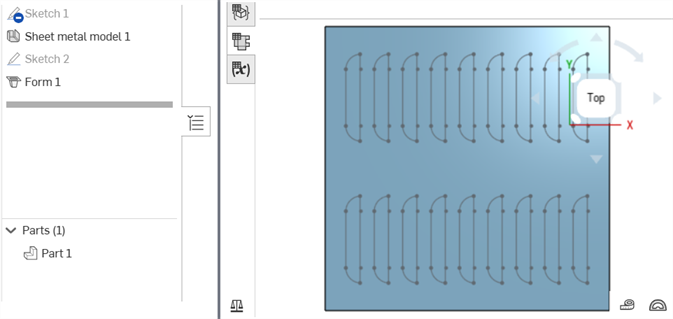
금속 판재 평면도에 표시되는 양식 스케치
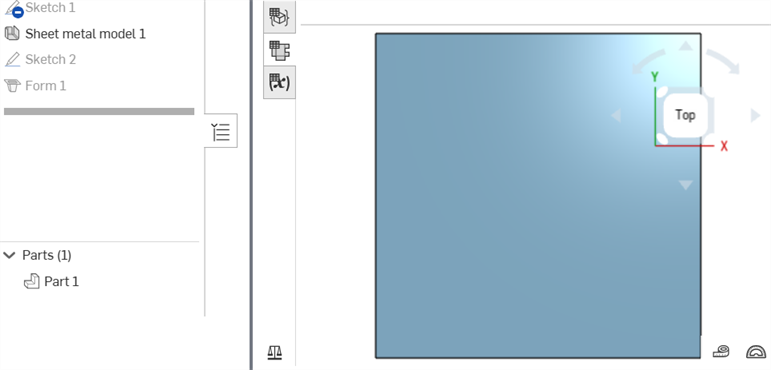
금속 판재 평면도에 숨겨진 양식 스케치
금속 판재 모델이 활성화된 경우(생성 또는 편집 중), 추가 도구를 사용할 수 있습니다.
-
 플랜지 - 선택한 각 모서리에 대해 벽을 생성하고 선택한 모서리에 굽힘으로 연결합니다.
플랜지 - 선택한 각 모서리에 대해 벽을 생성하고 선택한 모서리에 굽힘으로 연결합니다. -
 둘러싸기 - 기존의 금속 판재 파트에서 선택한 각 모서리/면에 대해 둘러싸기를 생성합니다.
둘러싸기 - 기존의 금속 판재 파트에서 선택한 각 모서리/면에 대해 둘러싸기를 생성합니다. -
 탭 - 금속 판재 플랜지에 탭을 추가합니다.
탭 - 금속 판재 플랜지에 탭을 추가합니다. -
 굽힘 - 추가 굽힘 제어 옵션을 사용하여 참조선을 따라 금속 판재 모델을 굽힙니다.
굽힘 - 추가 굽힘 제어 옵션을 사용하여 참조선을 따라 금속 판재 모델을 굽힙니다. -
 양식 - 기존 금속 판재 모델에 양식 피처를 생성합니다. 현재 통합문서, 다른 통합문서 또는 미리 정의된 금속 판재 양식 라이브러리에서 양식을 선택할 수 있습니다.
양식 - 기존 금속 판재 모델에 양식 피처를 생성합니다. 현재 통합문서, 다른 통합문서 또는 미리 정의된 금속 판재 양식 라이브러리에서 양식을 선택할 수 있습니다. -
 조인트 만들기 - 두 벽의 교차점을 굽힘(원통형 형상으로 결합된 벽) 또는 립(두 벽 사이의 작은 간격)과 같은 조인트 피처로 변환합니다.
조인트 만들기 - 두 벽의 교차점을 굽힘(원통형 형상으로 결합된 벽) 또는 립(두 벽 사이의 작은 간격)과 같은 조인트 피처로 변환합니다. -
 코너 - 코너 유형과 릴리프 스케일을 수정합니다.
코너 - 코너 유형과 릴리프 스케일을 수정합니다. -
 굽힘 릴리프 - 굽힘 릴리프(굽힘 끝이 자유 모서리와 만나는 작은 컷), 깊이 및 릴리프 너비를 수정합니다.
굽힘 릴리프 - 굽힘 릴리프(굽힘 끝이 자유 모서리와 만나는 작은 컷), 깊이 및 릴리프 너비를 수정합니다. -
 조인트 수정 - 굽힘을 립으로 변환하는 등 기존의 조인트에 대한 변경을 수행합니다. 현재 플랫 뷰 테이블을 통해 사용할 수 있습니다.
조인트 수정 - 굽힘을 립으로 변환하는 등 기존의 조인트에 대한 변경을 수행합니다. 현재 플랫 뷰 테이블을 통해 사용할 수 있습니다. -
 코너 분리 - 필렛이나 모따기를 적용하여 기존 금속 판재 파트의 코너를 끊습니다. 코너 모서리 또는 꼭지점을 선택하고 코너 분리 유형과 거리를 지정합니다. 금속 판재 모델의 모든 플랜지와 조인트를 완성한 후에 이 피처를 사용하는 것이 좋습니다.
코너 분리 - 필렛이나 모따기를 적용하여 기존 금속 판재 파트의 코너를 끊습니다. 코너 모서리 또는 꼭지점을 선택하고 코너 분리 유형과 거리를 지정합니다. 금속 판재 모델의 모든 플랜지와 조인트를 완성한 후에 이 피처를 사용하는 것이 좋습니다. -
 금속 판재 테이블 및 플랫 뷰 - 금속 판재 모델 플랫 패턴의 립/굽힘 테이블 및 시각화를 열고 닫습니다. 이 테이블을 사용하여 립을 굽힘으로 변환하거나 반대로 변환할 수 있습니다.
금속 판재 테이블 및 플랫 뷰 - 금속 판재 모델 플랫 패턴의 립/굽힘 테이블 및 시각화를 열고 닫습니다. 이 테이블을 사용하여 립을 굽힘으로 변환하거나 반대로 변환할 수 있습니다. -
 금속 판재 모델 마감 - 금속 판재 모델을 닫거나 비활성화하고 피처 리스트에 피처를 생성합니다.
금속 판재 모델 마감 - 금속 판재 모델을 닫거나 비활성화하고 피처 리스트에 피처를 생성합니다.
금속 판재 양식 피처에 대한 iOS 및 Android 지원은 데스크톱(브라우저) 플랫폼에서 작성된 양식 보기로 제한됩니다.
금속 판재 모델이 활성화된 경우(생성 또는 편집 중), 추가 도구를 사용할 수 있습니다.
-
 플랜지 - 선택한 각 모서리에 대해 벽을 생성하고 선택한 모서리에 굽힘으로 연결합니다.
플랜지 - 선택한 각 모서리에 대해 벽을 생성하고 선택한 모서리에 굽힘으로 연결합니다. -
 탭 - 금속 판재 플랜지에 탭을 추가합니다.
탭 - 금속 판재 플랜지에 탭을 추가합니다. -
 조인트 만들기 - 두 벽의 교차점을 굽힘(원통형 형상으로 결합된 벽) 또는 립(두 벽 사이의 작은 간격)과 같은 조인트 피처로 변환합니다.
조인트 만들기 - 두 벽의 교차점을 굽힘(원통형 형상으로 결합된 벽) 또는 립(두 벽 사이의 작은 간격)과 같은 조인트 피처로 변환합니다. -
 코너 - 코너 유형과 릴리프 스케일을 수정합니다.
코너 - 코너 유형과 릴리프 스케일을 수정합니다. -
 굽힘 릴리프 - 굽힘 릴리프(굽힘 끝이 자유 모서리와 만나는 작은 컷), 깊이 및 릴리프 너비를 수정합니다.
굽힘 릴리프 - 굽힘 릴리프(굽힘 끝이 자유 모서리와 만나는 작은 컷), 깊이 및 릴리프 너비를 수정합니다. -
 코너 분리 - 필렛이나 모따기를 적용하여 기존 금속 판재 파트의 코너를 끊습니다. 코너 모서리 또는 꼭지점을 선택하고 코너 분리 유형과 거리를 지정합니다. 금속 판재 모델의 모든 플랜지와 조인트를 완성한 후에 이 피처를 사용하는 것이 좋습니다.
코너 분리 - 필렛이나 모따기를 적용하여 기존 금속 판재 파트의 코너를 끊습니다. 코너 모서리 또는 꼭지점을 선택하고 코너 분리 유형과 거리를 지정합니다. 금속 판재 모델의 모든 플랜지와 조인트를 완성한 후에 이 피처를 사용하는 것이 좋습니다. -
 금속 판재 모델 마감 - 금속 판재 모델을 닫거나 비활성화하고 피처 리스트에 피처를 생성합니다.
금속 판재 모델 마감 - 금속 판재 모델을 닫거나 비활성화하고 피처 리스트에 피처를 생성합니다.
양식 라이브러리는 양식을 포함하는 특수 폴더입니다. 이러한 파트는 Part Studios에서 금속 판재 모델에 추가하거나 금속 판재 모델에서 제거하기 위한 템플릿으로 사용되는 부품입니다. 각 엔터프라이즈/Company는 관리자가 소유하고 엔터프라이즈/Company에 대한 공유 권한을 부여한 하나의 양식 라이브러리를 가질 수 있습니다. 그러면 엔터프라이즈/Company의 모든 사용자가 지정된 폴더의 서식에 액세스하고 사용할 수 있습니다. 또한 각 개인은 개인 용도로 사용할 양식 라이브러리 하나를 설정할 수 있습니다. 이 폴더에는 특별한 권한이 필요하지 않습니다. 이 개인 양식 라이브러리는 개별 사용자가 액세스하고 사용할 수 있습니다.
Onshape는 Onshape 금속 판재 양식 라이브러리에서 표준 금속 판재 양식 콘텐츠를 제공합니다. 자세한 내용은 Onshape 금속 판재 양식 라이브러리를 참조하십시오.
-
파트는 Part Studio에서 생성 및 저장됩니다. 그러면 이러한 Part Studio가 포함된 통합문서가 Onshape 폴더에 저장됩니다. 라이브러리를 설정하고 구성하는 방법에 따라 통합문서 페이지에서 폴더를 생성합니다(생성 > 폴더). 엔터프라이즈/Company 라이브러리는 루트 폴더에 생성해야 합니다.
-
엔터프라이즈/Company 라이브러리인 경우, 통합문서 목록에서:
-
계층 구조의 루트 폴더에서 공유
 아이콘을 클릭하여 공유 설정 대화상자를 엽니다.
아이콘을 클릭하여 공유 설정 대화상자를 엽니다.
-
팀 탭을 선택합니다.
-
모든 엔터프라이즈/Company 사용자 팀을 검색하고 추가합니다.
-
통합문서 연결 및 공유 확인란을 선택합니다.
-
공유 버튼을 클릭합니다.
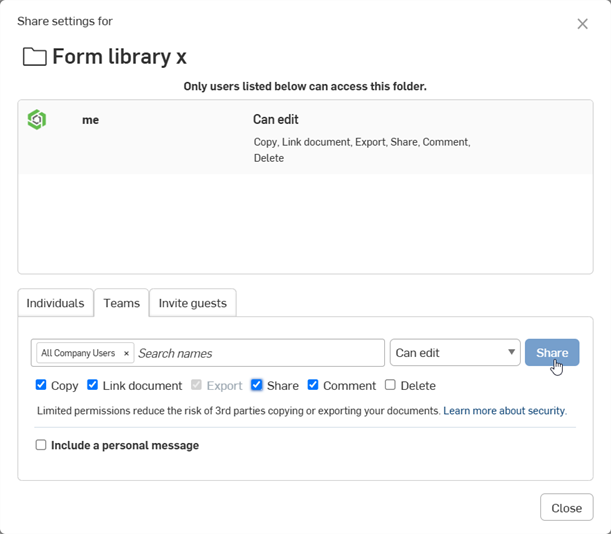
-
닫기 버튼을 클릭합니다.
-
-
통합문서 페이지에서 양식 폴더를 마우스 오른쪽 버튼으로 클릭하고 > 라이브러리 내 금속 판재 양식 설정을 선택합니다. 라이브러리를 처음 설정하면 폴더 아이콘이 변경되어 이 폴더가 양식 라이브러리(
 )임을 나타냅니다.
)임을 나타냅니다.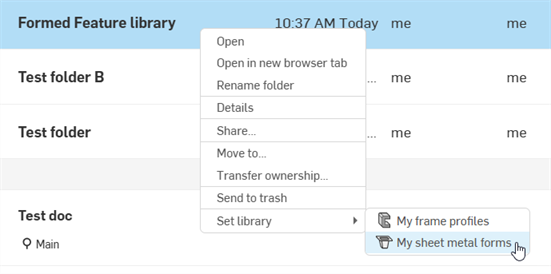
양식 라이브러리에 양식이 있을 필요는 없습니다. 금속 판재 모델과 동일한 통합문서 또는 양식 라이브러리 외부의 다른 통합문서에 양식을 작성할 수 있습니다.
양식 파트는 다음 두 가지 조건을 충족해야 합니다.
-
파트를 포함하는 Part Studio에는 두께라는 구성 변수가 있어야 하며 유형은 길이로 설정되어야 합니다.
-
양식 부분에는 태그를 지정해야 합니다.
Part Studio당 하나의 유효한 양식 태그 피처만 사용할 수 있습니다. Part Studio당 양식 1개를 생성하십시오.
다른 통합문서의 양식을 외부에서 참조하는 경우에도 통합문서 버전을 만들어야 합니다.
양식 통합문서를 만들려면 다음과 같이 하십시오.
-
사용자 또는 엔터프라이즈/클래스룸 양식 라이브러리 폴더에서 양식을 만드는 경우 해당 폴더로 이동하여 생성 > 통합문서를 클릭합니다. 그렇지 않으면 양식을 작성할 문서를 열고 새 Part Studio 탭을 삽입하십시오.
-
통합문서의 Part Studio 탭에서, 양식을 정의하는 하나 이상의 파트를 생성합니다. 이러한 파트는 금속 판재에 추가하거나 금속 판재에서 제거한 파트(또는 둘 다)일 수 있습니다.
-
다음 형식의 구성 변수를 생성합니다.
-
이름 = 두께
-
유형 = 길이
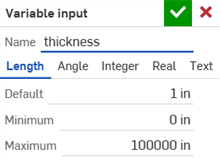
두께 FeatureScript ID는 금속 판재 모델 피처의 두께 값에서 양식 두께를 제어하는 데 사용됩니다. 자세한 내용은 구성 및 테이블 편집을 참조하십시오.
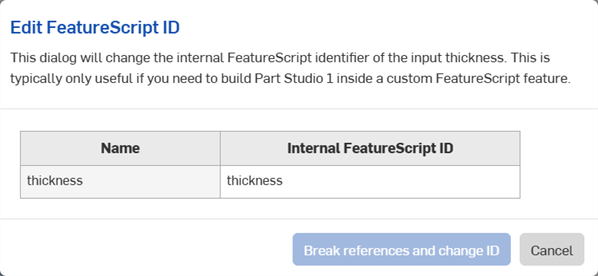
-
-
(선택 사항) 양식을 만들 때 추가 구성 변수를 사용합니다. 양식 피처의 Part Studio 선택 대화상자를 통해 양식을 선택하면 이러한 변수가 양식 아래에 입력 옵션으로 표시됩니다.
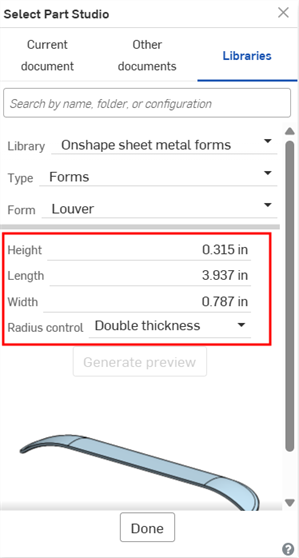
-
태그 피처를 작성하고 파트에 태그를 지정합니다.
-
통합문서 패널에서 버전 생성을 클릭합니다. 버전 이름과 선택적인 설명을 입력합니다. 그런 다음 생성 버튼을 클릭합니다.
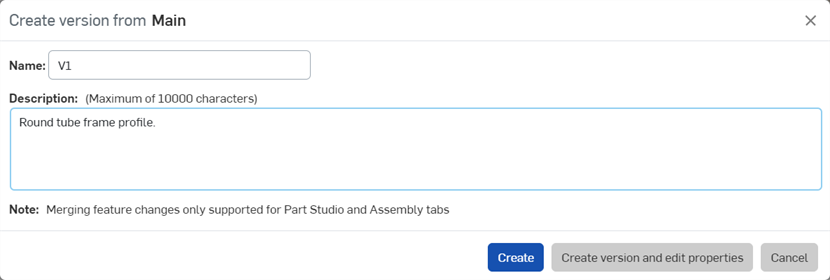
-
양식 문서가 사용자 또는 Company/엔터프라이즈 양식 라이브러리에 있는 경우 양식 라이브러리를 업데이트하십시오.
금속 판재 모델에 이 양식을 추가하는 방법에 대한 자세한 내용은 위의 단계 섹션을 참조하십시오.
통합문서 페이지에서 양식 라이브러리 폴더를 마우스 오른쪽 버튼으로 클릭하고금속 판재 양식 라이브러리 > 내 라이브러리 설정 해제(아래 그림 참조)를 선택합니다. 이렇게 하면 폴더의 사용자 또는 엔터프라이즈/Company 라이브러리 지정이 제거되지만 폴더 또는 해당 콘텐츠는 삭제되지 않습니다. 폴더가 표준 폴더 아이콘으로 변경되어 이 폴더가 표준 폴더임을 나타냅니다(![]() ).
).
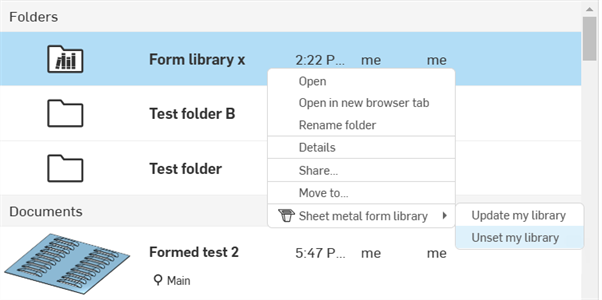
양식 라이브러리 폴더 내의 양식 통합문서를 변경한 경우 새 변경 내용이 해당 양식을 참조하는 모든 양식 피처에 적용되도록 폴더를 업데이트해야 합니다.
통합문서 페이지에서 양식 라이브러리 폴더를 마우스 오른쪽 버튼으로 클릭하고 금속 판재 양식 > 라이브러리 내 라이브러리 업데이트를 선택합니다 .
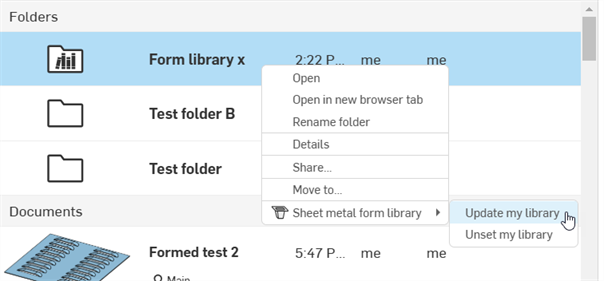
양식 라이브러리에서 양식을 업데이트해도 해당 양식을 참조하는 기존 모델은 여전히 이전 양식을 사용합니다. 양식을 업데이트하려면
-
양식을 사용하는 금속 판재 모델 통합문서를 엽니다.
-
피처 리스트에서 양식 피처를 두 번 클릭합니다.
-
Part Studio 양식 필드(아래 이미지의Louver C)를 클릭하여 Part Studio 선택 대화상자를 엽니다.
-
양식 레이블(이전 버전)이 표시되고 일반 양식 썸네일이 표시됩니다. 이는 모두 모델이 이전 버전의 양식을 사용하고 있음을 나타냅니다. 양식 드롭다운을 클릭하여 선택 메뉴를 엽니다.
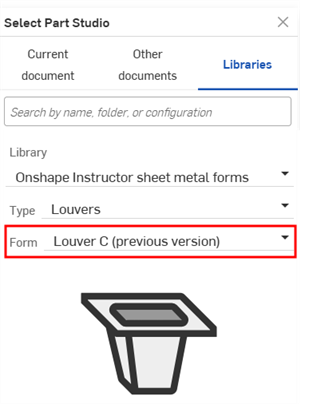
-
목록에서 업데이트된 양식을 선택하고 완료를 클릭합니다.
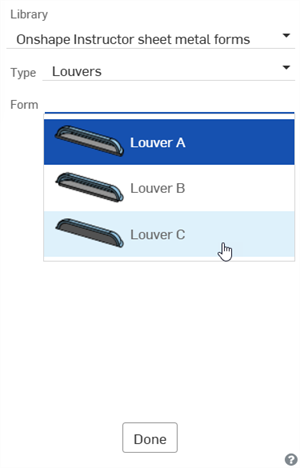
다른 폴더 수준을 추가하려면:
-
통합문서 페이지로 이동하여 새 폴더 레벨을 추가할 폴더 아래로 이동합니다(이 예시에서는 네 번째 레벨의 폴더가 추가됩니다). 그런 다음 새 폴더를 만듭니다.

-
새 폴더 대화상자에 폴더 이름을 입력하고 만들기를 클릭합니다.
-
통합문서 페이지에서 폴더를 선택하고 속성 아이콘(
 )을 클릭하여 오른쪽 패널에서 폴더의 속성을 엽니다 (아래 이미지 참조).
)을 클릭하여 오른쪽 패널에서 폴더의 속성을 엽니다 (아래 이미지 참조). -
라이브러리 라벨 필드에 폴더 라벨을 입력합니다. 실행 취소(
 ) 및 다시 실행(
) 및 다시 실행( ) 버튼을 사용하여 이 필드에서 텍스트를 제거하거나 텍스트를 다시 작성합니다.
) 버튼을 사용하여 이 필드에서 텍스트를 제거하거나 텍스트를 다시 작성합니다. -
적용을 클릭합니다.

-
폴더에 양식 문서를 추가합니다.
-
양식 프로필 라이브러리의 루트 폴더로 이동합니다. 마우스 오른쪽 버튼을 클릭하고 양식 프로필 라이브러리 > 내 라이브러리 업데이트를 선택합니다.

-
통합문서를 열고 양식 피처 아이콘을 클릭한 다음 Part Studio 선택 대화상자를 엽니다. 이제 다음 양식을 표시하는 네 번째 레벨이 있습니다.

양식과 함께 네 번째 폴더 수준을 보여주는 Part Studio 선택 대화상자
폴더 트리의 마지막 폴더에 양식 통합문서가 하나 이상 있어야 합니다.

노트
-
엔터프라이즈/Company 라이브러리 폴더의 경우, 라이브러리 라벨은 Onshape 통합문서 및 Onshape 폴더 의 범주에서 상속되므로 이러한 범주를 제거하면 라이브러리 라벨 필드가 더 이상 표시되거나 사용할 수 없게 됩니다. 이러한 범주가 이전에 제거된 경우 상위 범주 찾기 및 추가 드롭다운을 사용하여 범주를 추가하십시오.

-
폴더가 2개 이하인 경우 라벨이 필요하지 않으며 자동으로 유형 및 양식이라는 순서로 라벨이 지정됩니다.
-
동일한 통합문서에 각각 고유한 Part Studio에 양식이 여러 개 있는 경우 통합문서에도 라이브러리 라벨 속성이 있어야 합니다.


동일한 통합문서에 있는 여러 루버 양식
-
폴더 트리의 마지막 폴더에 양식 통합문서가 하나 이상 있어야 합니다.
-
폴더가 3개 이상인 경우 모든 폴더에 라벨이 적용되어 있어야 합니다. 그렇지 않은 경우 라이브러리를 업데이트할 때 다음 메시지가 표시됩니다.

-
최대 10개의 기본 폴더 수준(루트 폴더 포함)을 추가할 수 있습니다.
-
기본 10개 폴더 수준 중 하나에서 폴더를 분기할 수 있습니다. 예를 들어 네 번째 폴더에는 필요한 만큼 폴더를 만들 수 있으며 각 폴더는 폴더 레벨이 10개일 수 있습니다.
-
양식 라이브러리에 양식이 있을 필요는 없습니다. Part Studio의 모든 파트는 유효한 양식 통합문서이고 양식 통합문서 요구 사항을 충족하는 한 사용할 수 있습니다.
-
양식 라이브러리 폴더를 삭제할 수 없습니다. 먼저, 폴더의 설정을 취소한 다음, 삭제하십시오.
-
양식 라이브러리 폴더에 대한 공유 권한은 편집할 수 없습니다. 먼저 폴더를 설정 해제합니다. 그런 다음 폴더의 공유 권한을 수정합니다.
-
각각 고유한 양식이 있고 모두 하나의 통합문서에 있는 여러 개의 Part Studio를 생성합니다. 통합문서에 여러 양식이 있는 경우 Part Studio 선택 대화상자에 통합문서 이름을 표시하는 새 유형 필드와 Part Studio가 선택된 양식 드롭다운이 표시됩니다.
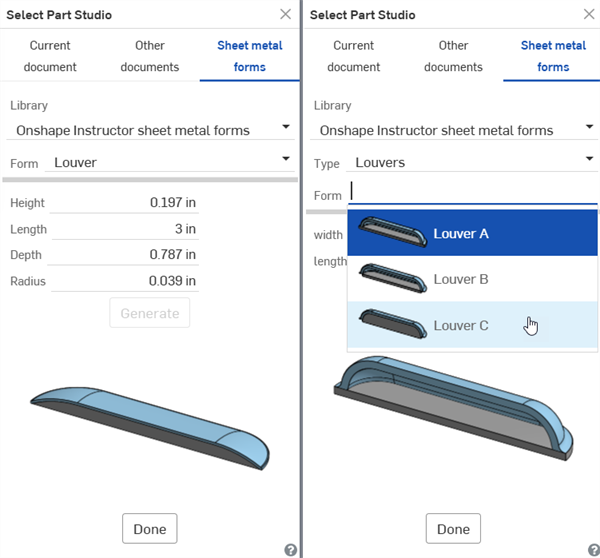
통합문서 내 1개 Part Studio의 1개 양식(왼쪽), 통합문서 내 여러 Part Studio의 여러 양식(오른쪽)